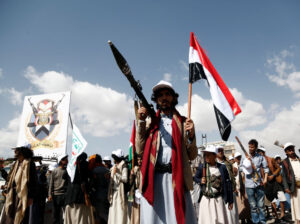In assessing Israel’s post-October 7 military campaign in Gaza, it helps to recall Clausewitz’s dictum that war, though horrific, isn’t ultimately about killing and destruction for the sake of it but a means for states to achieve their political goals. Seen in this light, Israel’s war has already failed. Never has the Jewish state been so isolated internationally. Never has this nation, founded following the Holocaust, had to face formal allegations of genocide at the International Court of Justice.
Worse, Israel’s standing in the United States, its most stalwart supporter, has suffered, its popular support fallen and falling. More broadly, the war has led to an unprecedented erosion in support for Israel above all among Democrats and young people, including American Jews. For the first time, an American president seeking re-election worries that his support for Israel, typically an asset in any political campaign in the United States, could contribute to his defeat. His campaign rallies have been interrupted by hecklers yelling “Genocide Joe” and berating him for abetting war crimes. According to recent survey, nearly a third of American adults believe the Gaza war amounts to genocide. And now, American university campuses are roiled by anti-war protests, which some Jewish students have joined.
More pertinently for the immediate situation in Gaza, Israel’s government appears to lack any post-war plan. And that matters. Even in the unlikely event that Netanyahu achieves all his started objectives in Gaza — freeing the hostages while also destroying Hamas seems impossible — more than nine million Israelis and more than five million Palestinians in the West Bank and Gaza are fated to live cheek-by-jowl. Neither community plans to depart, nor can they be expelled. The dreams of the most radical Palestinian movements of destroying the Jewish state and the calls from some within Israel’s hard-Right to expel Gazans en masse are equally fantastical. So, what can we expect after the war ends?
The most likely scenario is that Israel’s leaders will continue the policy that, despite intermittent negotiations with the Palestinians, has been in place since 1967, when Israel took control of the West Bank and Gaza following the Six-Day War. Often called “mowing the grass”, it boils down to the open-ended occupation and suppression of Palestinians, using massive force when deemed necessary. One example of the latter is Operation Cast Lead (2008-2009), which followed peaceful Palestinian protests that gave way to rocket and mortar attacks by Hamas. Over 22 days, the IDF killed some 1,400 Palestinians, including 300 children, its deadliest war in Gaza before the current one. Another, Operation Protective Edge (2014), left nearly 1,400 Palestinians civilians dead, including 500 children. On a smaller scale, mowing the grass features intermittent clampdowns on Palestinian resistance to occupation and dispossession. The by-product of this approach has been, and will surely continue to be, an endless cycle of bloodletting. The sole uncertainty: how much time will elapse between one phase of violence and the next and how long each last.
Yet mowing the grass doesn’t rely on naked force alone. To avoid directly ruling the West Bank Israel has relied on the Palestinian Authority (PA) for day-to-day governance. To replicate this arrangement in post-war Gaza, Israel will have to persuade people who enjoy legitimacy and respect in the community to serve as administrators in place of Hamas. The alternative, military rule, is a recipe for rebellions and violence that will entrap the IDF indefinitely. And the problem here is that, after the carnage and destruction in Gaza, few if any non-Hamas notables will rush to volunteer. Some eventually may, but risk being viewed as quislings and discredited as the PA has been. Aside from its corruption and ineptitude, the PA has come to be seen as Israel’s subcontractor. In a November-December 2023 survey by the Palestinian Center for Survey Research, 60% of West Bank residents said they wanted the PA dissolved.
Despite the pitfalls, perhaps local notables will agree to govern their territory, either because the IDF succeeds in destroying Hamas or because Hamas has forfeited Gazans’ support by perpetrating the October 7 that led to the pitiless Israeli bombardment in the first place. Then again, the many thousands of young men who have seen their parents and siblings killed, their homes and neighbourhoods demolished, and their own lives upended, may equally become a deep recruitment reservoir for follow-on armed resistance movements. Israel may end up creating more extremists than it has killed. Though Hamas may die, its animating ideology could live on.
Though far from homogenous, the anti-war Left that has organised around this war shares a simple ambition: Israel should jettison this “mowing the grass” model and resume negotiations aimed at a two-state solution, which has only been pursued in fits and starts since the Oslo Accords of 1993 and 1995. Those summits did have some concrete accomplishments: Israel’s recognition of the Palestinian Liberation Organization (PLO) as the representative of the Palestinian people; the PLO’s renouncing of terrorism and accepting the legitimacy of Israel as a Jewish state; and the creation of the Palestinian Authority. All this was a pathway to a Palestinian state, albeit with undefined contours, encompassing the West Bank and Gaza.
That ultimate goal seemed achievable on at least two occasions: the first was the 2000 Camp David talks between PA Chairman Yasser Arafat and Israeli Prime Minister Ehud Barak, with President Bill Clinton mediating, exerting pressure, and presenting a far-reaching proposal. Then, in 2008, Prime Minister Ehud Olmert put forward his own two-state proposal. Both initiatives envisioned Israel living in peace alongside a Palestinian state encompassing most of the West Bank and Gaza, with a corridor between the two places, the incorporation of the largest West Bank Jewish settlement blocks (such as Ariel and Ma’ale Adumim) into Israel, and the Palestinians compensated through “land swaps”. The negotiations failed for many reasons, including the status of East Jerusalem (who would control what and how) and the right of return for Palestinian refugees displaced in 1948 (how many and where).
These structural obstacles remain. But the two-state solution also becomes progressively harder to achieve so long as Israel, while mowing the grass, keeps building Jewish settlements on the West Bank and ignores the “outposts” proliferating there — along with roads reserved for Jews — despite the lack of the government’s consent. A record 23 outposts were built in 2023, and there are now 160 West Bank settlements inhabited by 520,000 people, not counting another 250,000 in East Jerusalem; add to that the outposts in which as many as 30,000 people live. Not only are additional settlements (with 3,500 homes) planned, the hard-line Finance Minister Bezalel Smotrich recently urged the legalisation of 68 outposts. Following the Gaza War, the government also announced the appropriation of 800 hectares in the Jordan Valley to build more settlements — the biggest confiscation of Palestinian land in 30 years. In a move that further fragments the West Bank, the government recently earmarked $940 million for renovating and constructing roads for the exclusive use of settlers. Steps like these demonstrate its rejection of the two-state solution and its determination to create “facts on the ground” that will make it even harder for future Israeli leaders to achieve that goal.
True, the settlers are a small segment of Israel’s population, but they are also a powerful one. They regard the West Bank (Judea and Samaria) as a divine gift bequeathed to Jews for eternity, and Right-wing parties draw strong support from them. True, largest settlement clusters could be joined to Israel as part of a two-state deal and balanced by land swaps, but Palestinians are right in arguing that all settlements are illegal under international law, no matter that Israel has insisted they must demonstrate their readiness to compromise by accepting them. This point of view is increasingly in the political ascendant following the collapse of the Israeli Left, the growing power of Right-wing parties and movements, the increase in settlements, and the expropriation of more and more Palestinian land to make way for them. Unsurprisingly, polls show that disillusionment with this 30-year quest has reduced support for it: less than a third of Jews and only 37% of Palestinians back it.
The most modish panacea to this intractable problem, a one-state solution — a single state that stretches from the Jordan River to the Mediterranean Sea and ensures equal rights to Jews and Palestinians (Muslims and Christians) alike — is even less likely. It contradicts the fundamental principle underlying the Zionist project, namely that Jews must have their own homeland. Moreover, there’s little evidence that replacing the Jewish state created in 1948 with one that provides Jews and Palestine the same rights has much appeal even among Israelis on the Left. It would be an even harder sell now because it will require Israelis to abandon deeply rooted conceptions of self and nation at a time when the Gaza war has increased their both distrust of Palestinian leaders and their vigilance about security.
For now, there is no chance that this idea will take wing. The Netanyahu government rejects a two-state solution, which won’t even entertain even the thought of it — unless it involves a single one between the river and the sea with no more than a small minority of Palestinians in it. The same goes for future governments that are formed by or include parties from the political Right. As for the long run, the Right-ward trajectory of Israel’s politics — partly due to demographic trends favouring Right-wing voters — all but guarantees that the one-state vision will remain just that.
In times of stress and uncertainty people hold fast to what’s familiar. Perhaps the Gaza war will be an exception and prove to be a catalyst that shakes things up and — despite the fear and suspicion on both sides, Israelis and Palestinians — creates the conditions for the bold political choices required to achieve the two-state solution. That would be nice but not likely — not until the passage of time reduces the Gaza War’s psychological grip on Israeli Jews and Palestinians, the ideology of extremists in both communities lose ground, and a new generation rooted in the centre and Left moves Israel in a different direction. Until then, Israeli leaders will fall back on “mowing the grass”. But we know, now better than ever, where that can lead.
Disclaimer
Some of the posts we share are controversial and we do not necessarily agree with them in the whole extend. Sometimes we agree with the content or part of it but we do not agree with the narration or language. Nevertheless we find them somehow interesting, valuable and/or informative or we share them, because we strongly believe in freedom of speech, free press and journalism. We strongly encourage you to have a critical approach to all the content, do your own research and analysis to build your own opinion.
We would be glad to have your feedback.
Source: UnHerd Read the original article here: https://unherd.com/



